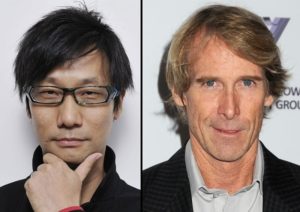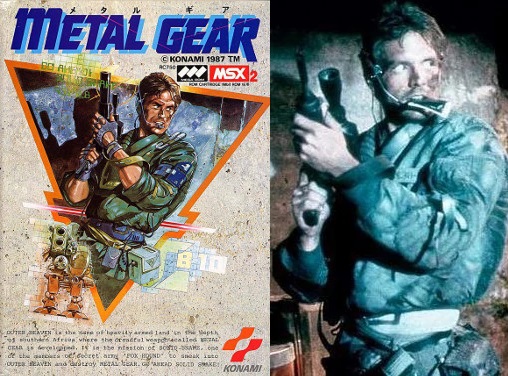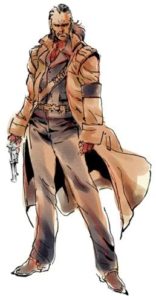This is something I’ve been meaning to write about for at least ten years but never did. This is mostly because I didn’t feel I had my thoughts together enough to get my point across — and I may yet fail in the attempt here. Though I think my purpose can be understood by the title alone if you’re familiar with both names.

One is a famous game designer and the other a famous film director. The former is considered a genius by many who play, write about or produce lengthy “video essays” about video games. The latter is considered a hack by many film critics but his films are generally financially successful and popular with general audiences. This difference in appreciation by critics in the two mediums matters because the style and themes both use in their works are very similar and nobody could reasonably deny that Kojima has taken obvious inspiration from Michael Bay films as well as plenty of similar films— particularly in the action genre. Yet, one is considered a genius in their medium while the other is considered a hack. Is this reasonable?
No, it isn’t.
First, it is important that I make it clear that I don’t dislike Kojima’s games. I have played Metal Gear Solid and the four main sequels and I have even played his earlier Snatcher adventure game on the Sega Mega CD. I even went to see him at a public appearance promoting Metal Gear Solid: Peace Walker for the PSP in Japan. I don’t consider him to be a bad game designer but I do certainly consider claims that he is some kind of genius to be more than a little overstated. I also don’t dislike Michael Bay as so many seem to. One of my favourite action films is The Rock (which Kojima clearly enjoyed too), and I also loved the Transformers live-action film from 2007.
It isn’t exactly a secret that Kojima is a big movie buff and that many characters and motifs are derived from films he enjoyed. The most obvious and immediate is his most well known character Snake in his various forms. It may be tedious to some readers to explain that this is not one character and there are also many different variations of this name. Nonetheless, Snake is based on Kurt Russel’s character Snake Plissken from Escape from New York and its lesser appreciated sequel. This is made explicit when the surname was used (with a slight spelling variation) as an alias by the character in Metal Gear Solid 2: Sons of Liberty. This may seem to be overexplaining but if you know anything of Kojima’s convoluted storytelling in the Metal Gear series, you would realise I’m doing my upmost to maintain brevity

The point of all the above is that his most successful and recognised character is clearly and closely derived from another. Even the front cover of the original Metal Gear copied the likeness of Michael Biehn as Kyle Reese in The Terminator. When this was done in the 1980s, games could get away with a lot more “borrowing” than they can now. Games were often based on film licenses and where they weren’t, there was usually an obvious influence. There are a legion of examples including titles such as Ikari Warriors, Commando and Golden Axe that had obvious film influences.

Snatcher was the next major game Kojima worked on after the original Metal Gear which borrows its concept from Blade Runner and The Terminator. This was originally developed for the Japanese PC market but is known in the West for the Sega Mega CD port which to this day, remains the only official English release. This also contains many of what have become signatures of Kojima’s design including long-winded exposition about political/corporate conspiracy and intrigue. It even features a Metal Gear robot! As mentioned above, I quite enjoyed this game and it was unique for the time but you’d be hard pressed to argue it wasn’t highly derivative.
Kojima really became well known following the release of Metal Gear Solid on the original Sony PlayStation. Although his name was probably known by enthusiasts prior to this, it was from this title onwards that his name could be used in promoting future games in the series. Though the series technically began with Metal Gear, most gamers weren’t familiar with it as it had only seen release as (what I understand to be), an inferior port to the Nintendo Entertainment System along with a sequel by another developer. Metal Gear Solid is where a significant amount of people had their first experience with a Kojima game and this includes this writer.
This game was notable in particular for really taking advantage of the CD-ROM format — even more than what was done in Snatcher. It was fully voice and a lot more professionally that most games had been up to that point. The original voice actor for Solid Snake, David Hayter did the most to distinguish the character from his otherwise derivative origins and very much made him his own. It also had an excellent soundtrack as well as visuals that were technically impressive at the time though the latter is much harder to appreciate today. Purely as a game, it still holds up well though I would argue the sequels mostly improved the gameplay.
The sequels that followed were all generally well-received and general consensus holds Metal Gear Solid 3: Snake Eater as the peak though I honestly preferred Metal Gear Solid 4: Guns of the Patriots. The final entry Metal Gear Solid V: The Phantom Pain was released in 2015 and around this time Kojima left or was forced out at the company. The exact details are not known but I tend to agree with Raz0rfist, that Kojima was by this point costing the company a lot more than he was bringing in. Death Stranding, his lone release since and one which he had full creative control over — strongly supports that argument.
So Kojima’s signature achievement was heading up the Metal Gear Solid series though he has a few other notable games to his name outside of this series. Most of these games were critically well-received and financially successful. Most games have been ported numerous times too though Metal Gear Solid 4 has curiously remained a PlayStation 3 since it was released in 2008.
Though not many in the industry could claim similar achievements, there are still quite a few big names either comparable or more successful. The main reason Kojima is singled out is usually because of the unique design choices and his excellent self-promotion which reached peak absurdity in MGSV where his name appeared in the credits at the beginning of every major mission in the game.

Going back to the derivative origins of the series, it is worth pointing out that Kojima never stopped using ideas he saw in movies and the whole series is littered with examples. I didn’t mention this earlier but something that first clued me to this early on was the similarity between the original Metal Gear Solid soundtrack and the aforementioned Michael Bay film The Rock which was released two years before the game. It occurs to me as I write that Kojima may also have been inspired by the way the Navy Seals enter Alcatraz island for Snake’s entry into Shadow Moses. Though a similar entry also happened at the beginning of Escape from L.A. which came out the same year.
For example, the exposition used to introduce John Mason played by Sean Connery in the clip above is exactly how story exposition tends to occur in the Metal Gear Solid series. There are also numerous other examples that could be clipped from this movie alone. I am actually surprised there isn’t a detailed scene by scene break down somewhere on YouTube.
Where Kojima is original, it is usually not that impressive. A lot of his characters have incredibly silly names that would not be taken seriously in other mediums but are played very straight in the games. Consider a gun-toting character named “Revolver Ocelot”, a mute (and scantily clad) sniper named “Quiet” and the antagonist being called “Liquid Snake”, the brother of “Solid Snake”. These aren’t even the silliest names that I could mention. Keep in mind too, that a lot of these characters appear in lengthy cutscenes throughout the series and the way the story unfolds in each is rarely tongue-in-cheek. I am sure people would have various ways to describe a Hollywood screenwriter who used names like this and I don’t think “genius” would be among them. The names in Death Stranding are no better.
 Quiet from MGSV wearing far from ideal clothing for combat in Central Asia
Quiet from MGSV wearing far from ideal clothing for combat in Central Asia
As mentioned, Kojima has some incredibly long-winded exposition which sometimes goes for well over an hour. I think MGS4 holds the record but there is at least one cutscene in the original that comes close to an hour if not more. These are video games where the players direct input is the main attraction and while these can all be skipped, they are also woven into the design. Many fans of the series love this and I must admit I didn’t skip any and particularly enjoyed those in the fourth entry. It doesn’t change that times between actual gameplay are often woefully short and that skipping them can easily break immersion more so than in similar games.
Some of the story developments are truly bizarre even by video game standards. Probably the silliest would be the aforementioned Revolver Ocelot becoming “Liquid Ocelot” after the dead Liquid Snake’s hand is attached to Ocelot — replacing the one that was chopped off by a cyborg ninja named Gray Fox. So a hand was able to possess a man’s entire body. This, once again, is an attempt at brevity as there is a lot more that could be added and remember this is all came from the head of someone that is supposedly a genius.
 Revolver Ocelot in the original Metal Gear Solid
Revolver Ocelot in the original Metal Gear Solid
I could go on and on from here but it is probably best to come back to the comparison from the beginning and finish. Michael Bay and Hideo Kojima have a number of things in common. They have both become more indulgent in their respective mediums with success — both men’s earlier work was far more restrained than their later work. Bay, with his use of visual effects that result now in some almost incomprehensible action scenes and Kojima with his long-winded dialogue and cutscenes. Both tend to use government/conspiracy tropes and Kojima has obviously borrowed from some of Bay’s films as well as other movies produced by Jerry Bruckheimer (with whom Bay has often worked). They also certainly like attractive women and often include gratuitous shots or images of beautiful women. Though Kojima’s is a lot more voyeuristic and perverse than Bay which I will cheekily ascribe to his nationality.
Hideo Kojima is considered one of the greatest game designers that has ever lived and is frequently described as a genius. Michael Bay, who Kojima has often borrowed from, is considered merely a successful director and it is hard to believe that he’ll ever be awarded an Oscar for his work. What is odder is that people who would describe Kojima as a genius, would be unlikely to show the same appreciation to Bay or similar directors despite the creative debt he owes them.
There is an obvious inconsistency here that needs to be addressed. Are video games a lower medium than film which elevates Kojima’s heavily derivative games? Or are they equal to film? If the latter, should this not lower Kojima in esteem? I think there needs to be an answer to this and I’ve not heard a good one from Kojima’s obsessive fanbase. For me it is simple. Kojima has made a number of great video games and Michael Bay has made a number of great films. Neither is a genius. If I had to pick a genius designer in the video game industry, it would not be Kojima. I would be looking at someone like John Carmack from a technical perspective or Shigeru Miyamoto strictly from a game design perspective. However I assumed that both of these men, unlike Kojima, would be too modest to accept such praise without reminding us of all the other people who contributed to their success.
Please note that wherever I have been long-winded and/or incoherent, it was in homage to Hideo Kojima.
